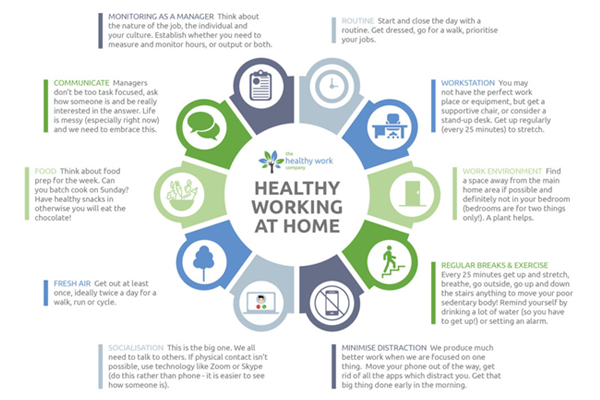|
OHS Tips For Home Working In Imperfect Circumstances
There is no doubt that as well as the anxiety provoked by a potentially deadly virus and no toilet roll or pasta in the supermarket, we are also facing the very likely fact that many workers will be being plunged into home working for the first time, to speak nothing of the potential requirements for isolation. Some of those workers may already have experience of a day or so a week, but few of them will have worked full time from home and few of their managers will have managed large teams in such a situation either.
A report from the World Economic Forum in 2019 pointed to the fact that a 2017 United Nations report found that 41% of remote workers reported high stress levels, compared to just 25% of office workers. The WEF believed that being ‘out of sight, out of mind’ and the tendency for managers to become increasingly task focused and actually attempt to micromanage more than before was partly to blame.
Conversely, Charalampous et al. in 2018 found that remote working was associated with higher workplace wellbeing with the benefit of flexibility and autonomy.
What we do know though, according to ACAS guidance is that “only suitable people should be offered the choice of regular remote working” (with suitability not just about them as people but also about their home set up). And here we are about to put everyone, suitable or not, into that boat, in an environment which is already highly charged.
The research on how to be a good home worker is mostly focused around entrepreneurs who are accountable just to themselves. The research on how to be a good manager of remote teams is sparse. If you work from home, your employer must make sure there is a risk assessment of your work activities. With the current government guidelines in place, HSE says it is not necessary for someone to visit you, but you should complete a questionnaire and provide appropriate evidence e.g. photographs. This will help decide if sufficient steps have been taken to prevent harm to you or anyone else who may be affected by your work. HSE has also said that a DSE risk assessment is not required for this period.
Work-Life Balance Campaign
Work-life balance has been on the political agenda since 2000 when the Government launched its Work-Life Balance Campaign. Home working comes under the category of flexible working arrangements, a concept which is actively promoted under the Employment Rights Act 1996, as amended by the Children and Families Act 2014. The Children and Families Act 2014 means that any employee with more than 26 weeks service can request flexible working, regardless of whether they are carers or parents. This legislation does not create a right to flexible working, but the employer has to consider a request seriously and there are set procedures for the employer to follow and the reasons for refusal have to be provided to the employee in writing.
|



